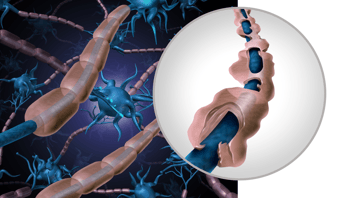Is it Ischemic or Hemorrhagic? Mastering the Art of Stroke Identification for Nursing Students
Are you ready to become an expert in stroke care? Dive into this essential guide, where we reveal the life-saving clues that differentiate ischemic from hemorrhagic strokes, knowledge every nursing student must have to excel in their future career!
What is a stroke?
So stroke essentially is a lack of oxygen delivery to the tissues, meaning that blood flow is interrupted or altered to the brain.
There are two classifications of stroke.
There’s ischemic stroke and hemorrhagic stroke. Within those different classifications, I mean there are multiple types of hemorrhagic stroke. You can have a bleed in many different areas of your brain. You can have subarachnoid hemorrhage and intracranial hemorrhage. You can have bleeding within different regions inside the brain that will affect different aspects as a person begins to recover.
So for example, you can have a bleeding in the pons area, bleeding in the basal ganglia and I’m just – an area in the brain can bleed and the mortality and the effects that that person will experience will vary depending on where their bleed is. That’s a discussion for another time.
Ischemic Stroke.
Ischemic stroke is a clot or blood flow is impeded to a specific area of the brain. The most common location for ischemic stroke is the MCA and that’s the middle cerebral artery which happens to be the place that is most commonly occluded with ischemic strokes.
So the majority of people that experience stroke actually have an ischemic stroke. Ischemic strokes make up about 80 to 85 percent of all strokes that people experience every year, with hemorrhagic strokes being only about 15 percent.
Now there are a few things that will exclude someone from being diagnosed with a stroke. We call those the three Ts.
- Trauma
- Tumor
- Table
So basically that means if the bleeding within their brain is caused or the occlusion within their brain is caused by trauma, falling off a ladder or something that – if the bleeding occurs due to that, that’s trauma and that excludes them from having the stroke diagnosis.
Table, that refers to surgery. If bleeding occurs within their brain or as a result of surgery, then we call that table and that excludes them from a stroke diagnosis.
The last one is tumor.
If it’s a tumor that creates the oxygen delivery alteration within their brain, then that’s going to also exclude them. So trauma, tumor, table, those are the three Ts that exclude people from actually being diagnosed as a stroke.
- So you have someone that is an ischemic stroke. They come in. What are some things that are currently being done for those patients? If you think about it, within the brain, you have to have your blood flow to the brain. An ischemic stroke is an occlusion of artery.
So there are two things that can be done. You’re going to need to take out that occlusion or you can bust that occlusion up. So the things that are done are called embolectomies or you administer TPA.
Now embolectomy is actually a guide wire inserted through the groin all the way up into the cerebral arteries, to the location of the clot, and a little cage or wire mesh net is passed over the clot and it actually retrieves that clot and pulls it out.
The goal with that – and that’s done in interventional radiology and the goal with that is to regain perfusion to the brain once that clot is actually removed.
The other option is TPA and that is administered to individuals. It’s called Tissue Plasminogen Activator and it’s given to people to break down blood clots.
So if someone comes into the hospital and they are exhibiting symptoms of an ischemic stroke, they can be a candidate for TPA administration. Now TPA, it’s a very potent medication. So it’s not appropriate for everyone and there’s actually about a 4.5-hour window of last known normal is what it’s called that TPA can be administered.
So from the last moment of the person was essentially normal, you really have only about 4.5 hours to administer that medication. Our biggest risk with TPA is going to be bleeding. As you break up that clot, of course TPA isn’t specific to just that one area and the brain that is occluded is going to – it’s going to be active throughout the entire body. So we really have to be careful as we administer that medication.
So there are a couple of things. We really want to administer it to people under the age of 80. We want to – so when someone comes in, they’re exhibiting signs of an ischemic stroke, weakness, hemiparesis, slurred speech. All those are signs of stroke.
The first thing they’re going to do is they’re going to send them over to CAT scan and the reason they send them to CAT scan is a bleeding within the brain will show up very rapidly on the CAT scan.
So once a person comes in with those signs of stroke, we try to determine if it’s ischemic or hemorrhagic. So we send them over to CAT scan, get a CT and if there is no bleeding within the brain, we begin to assume that it’s possibly an ischemic stroke. Now ischemic strokes do not actually show up on CT scan right away.
So we don’t really have that definitive diagnosis that it is a stroke. We just say that OK, they’re exhibiting stroke-like symptoms. We see no bleeding within the brain. Let’s continue on that line.
Another thing that you want to verify is that the person does not have low blood sugars, the confusion that somnolence and everything can be a sign of low blood sugar. So we check their blood sugar. Make sure it’s within appropriate range. We check the CT scan and the symptoms are still being exhibited. We continue to assume that it is a – it is due to the ischemic stroke.
So continue on down that pathway. Now prior to administering TPA, we check platelet count. We make sure it’s within appropriate range. We make sure the person hasn’t recently had a surgery or head trauma. Make sure they haven’t had a lumbar puncture and we just kind of make sure that we aren’t going to cause an additional problem by administering the TPA.
So a patient comes in. They’re ischemic stroke. We check their blood pressure. It’s 220 over 115. Now the reason for that is of course that the occlusion within the brain is requiring that the heart beat at a higher systolic pressure in order to perfuse the brain.
So prior to administering TPA, we generally keep patients’ blood pressure a little bit higher, over 200, 210, 220, systolically. Once TPA is administered, of course like I said earlier, we’re concerned about the risk of bleeding. So our goal with the systolic pressure is going to come down to about 185 just to prevent any further risk of bleeding. We just kind of lower that goal systolic pressure down a little bit.
We can do that with different medications to make sure that it stays below that level. But you really don’t want to take an ischemic stroke patient’s pressure down too low, because they do have that clot. We want to make sure that we continue to perfuse the brain.
So we administer the TPA. They’re taken up to the neuro ICU. We monitor them very closely. Vital signs are taken every 15 minutes. We perform our NIH which is basically a stroke scale to determine the severity of the stroke and we perform that every two – we perform that two hours after TPA administration and then we perform it every 12 hours for 48 hours and then on discharge.
It really is amazing to watch patients improve as the TPA – as the time passes, post-TPA. Now as I mentioned earlier, the biggest risk with TPA administration and ischemic stroke patients is going to be – is bleeding. Patients can actually have kind of a refractory hemorrhagic bleeding after the TPA. So we will administer the TPA. We will get repeat CT scans and within about 48 hours, 24, 48 hours, if we don’t see any signs of hemorrhagic stroke …






